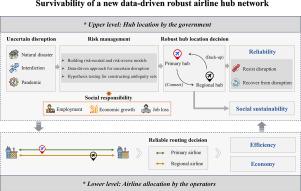基于风险规避准则的新型数据驱动稳健航空枢纽网络的生存能力增强
IF 11
1区 工程技术
Q1 ENGINEERING, INDUSTRIAL
引用次数: 0
摘要
航空公司网络设计中广泛采用的轮辐结构可能在中断期间引发级联效应,并导致进一步的损失。本文旨在通过优化可靠性、可持续性和效率,提高航空枢纽网络在设计阶段的生存能力。然而,在不可预测的中断(如封锁和自然灾害)下,考虑可靠性是具有挑战性的。在可用事件信息的激励下,通过数据驱动的鲁棒方法将不确定中断场景纳入可靠的航空枢纽网络设计是一种很有前途的解决方案。本文建立了双层多目标优化框架,在最坏情况均值和条件风险值准则下构建了新的风险中性和风险厌恶模型,其中通过统计假设检验构建数据驱动的模糊集,通过故障树分析确定经验概率分布。所构造的模糊集具有概率保证,有助于将所提出的模型转化为混合整数二阶锥规划模型,并设计了有效的分支切算法。通过实例验证了该算法的鲁棒性和可靠性。结果还表明,我们的数据驱动方法在样本外性能上优于随机优化方法,并且所提出的分支切断算法在计算效率上优于Gurobi求解器。本文章由计算机程序翻译,如有差异,请以英文原文为准。

Enhancing the survivability of a new data-driven robust airline hub network with risk-averse criterion
The widely adopted hub-and-spoke architecture in airline network designs can trigger cascading effects during disruptions and result in further losses. This paper aims to enhance the survivability of airline hub networks in the design phase by optimizing reliability, sustainability, and efficiency. However, it is challenging to account for reliability under unpredictable disruptions such as interdiction and natural disasters. Under the stimulation of available event information, it is a promising solution to incorporate uncertain disruption scenarios into reliable airline hub network design through a data-driven robust approach. This paper develops a bi-level multi-objective optimization framework, and builds new risk-neutral and risk-averse models under the worst-case mean and conditional-value-at-risk criteria, where data-driven ambiguity sets are constructed through statistical hypothesis testing, and empirical probability distribution is determined by fault tree analysis. The constructed ambiguity sets have probabilistic guarantee, which help us transform the proposed models into mixed-integer second-order cone programming models, for which an effective branch-and-cut algorithm is designed. Numerical experiments on a real case demonstrate the robustness and reliability of our location-routing decisions. The results also illustrate that our data-driven approach outperforms stochastic optimization approach in out-of-sample performance and that the proposed branch-and-cut algorithm surpasses the Gurobi solver in computational efficiency.
求助全文
通过发布文献求助,成功后即可免费获取论文全文。
去求助
来源期刊

Reliability Engineering & System Safety
管理科学-工程:工业
CiteScore
15.20
自引率
39.50%
发文量
621
审稿时长
67 days
期刊介绍:
Elsevier publishes Reliability Engineering & System Safety in association with the European Safety and Reliability Association and the Safety Engineering and Risk Analysis Division. The international journal is devoted to developing and applying methods to enhance the safety and reliability of complex technological systems, like nuclear power plants, chemical plants, hazardous waste facilities, space systems, offshore and maritime systems, transportation systems, constructed infrastructure, and manufacturing plants. The journal normally publishes only articles that involve the analysis of substantive problems related to the reliability of complex systems or present techniques and/or theoretical results that have a discernable relationship to the solution of such problems. An important aim is to balance academic material and practical applications.
 求助内容:
求助内容: 应助结果提醒方式:
应助结果提醒方式:


